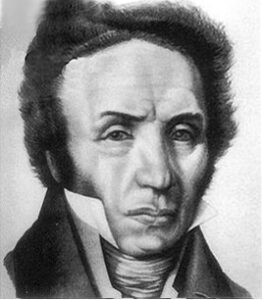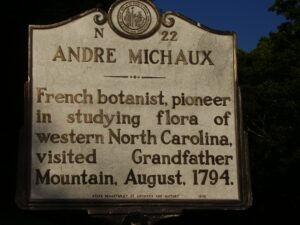Andre Michaux
History

Asa Gray (November 18, 1810 – January 30, 1888) is considered the most important American botanist of the 19th century. His Darwiniana was considered an important explanation of how religion and science were not necessarily mutually exclusive. Gray was adamant that a genetic connection must exist between all members of a species. He was also strongly opposed to the ideas of hybridization within one generation and special creation in the sense of its not allowing for evolution. He was a strong supporter of Darwin, although Gray’s theistic evolution was guided by a Creator.
As a professor of botany at Harvard University for several decades, Gray regularly visited, and corresponded with, many of the leading natural scientists of the era, including Charles Darwin, who held great regard for him. Gray made several trips to Europe to collaborate with leading European scientists of the era, as well as trips to the southern and western United States. He also built an extensive network of specimen collectors.
Andre Michaux
Marker ID: N22
Google Map
NC Highway Map
Nearest Town: Linville, NC
Date Cast: 1949
Marker Text
N22 – Andre Michaux
French botanist, pioneer in studying flora of western North Carolina, visited Grandfather Mountain, August, 1794.
Essay
André Michaux, botanist, explorer, and author, was born at Satory, near Versailles, France, on March 7, 1746, the son of a landlord of a royal estate. In 1769, after the death of his first wife, Cecil Claye, Michaux chose to devote his life to botanical study. A student of French naturalist Bernard de Juisseau, Michaux spent 1779-1781 studying in England, as well as in the Auvergne Mountains in France and the Pyrenees in Spain. In 1782 he received a commission from the French government to obtain a herbarium in Persia.
Three years after returning from Persia, Michaux was sent by Louis XVI to North America to study trees and ascertain their quality for naval construction. Working with his fifteen-year-old son, Michaux set up a nursery in New Jersey. He worked collecting specimens in New Jersey, Pennsylvania, and Maryland for nearly a year before moving his collection to Charleston, South Carolina.
In late 1787 Michaux made the first of five trips into the Appalachian Mountain range in search of plants and herbs. Following the route previously taken by William Bartram, Michaux entered North Carolina crossing the Georgia border and working his way along the French Broad River. He returned the following year, entering near Charlotte and following the Catawba River into Burke County, eventually crossing the Blue Ridge Mountains. For the next several years, Michaux visited Florida, the Bahamas, and Hudson Bay.
In 1793, the French government sent him to Kentucky and Tennessee, and he returned to North Carolina in 1794 and 1795. On the latter trips, he passed through Lincoln and Burke Counties and moved along the Appalachian range, visiting Roan Mountain, Mount Mitchell and the Black Mountains, Grandfather Mountain, and Linville Gorge. According to his own journal, having reached the summit of Grandfather Mountain, he sang out the French hymn “La Marseillaise” and exclaimed “Long live America, and long live the French Republic!” His many travels through the North Carolina mountains resulted in spectacular finds, one of which, the rare Carolina Lily, Lilium Michauxii, was named North Carolina’s official state wildflower in 2003.
Another major find of Michaux’s, although not directly named by him, was the Oconee Bell, Shortia galacifolia. In 1839, while searching through Michaux’s collections in Paris, botanist Asa Gray found an unclassified specimen with a simple note stating it had been found “high in the mountains of Carolina.” For the next four decades, Gray and several other botanists searched in vain for the flower. In 1877 they were found in Oconee County, South Carolina, but subsequently, small plots of the extremely rare flower have been found in the Appalachian Mountains.
The French Revolution deprived Michaux of his financial support. In August 1796 he left Charleston for France with an enormous collection of plants. Shipwrecked off Holland, Michaux saved most of his plants, but his journal of his North Carolina expedition was largely lost. In October 1800 he volunteered as the naturalist for an expedition headed to Australia, but left the group while on the island of Mauritania in the Indian Ocean. He remained there for six months, thoroughly enthralled by the plant and animal species. Michaux then moved his operations to Madagascar. In the fall of 1802 he became sick with fever, and died in November at the age of fifty-six.
Michaux wrote two books about his experiences, The History of North American Oaks, and Flora Boreali Americana. His son, Francois André Michaux, followed in his footsteps as a botanist and writer. In 1802-1803 he led an expedition across Ohio, Kentucky, Tennessee, and the Carolinas. He left an account of the venture, Travels to the West of the Alleghany Mountains. Although he spent little time in North Carolina, Michaux’s son left detailed descriptions of Morganton and Lincolnton.
Sources:
- Henry Savage and Elizabeth Savage, André and Francois André Michaux (1986)
- J. P. F. Deleuze, Memoirs of the Life and Botanical Travels of André Michaux (2002)
- David H. Rembert, André Michaux’s Travel and Plant Discoveries in the Carolinas (2004)
- Gail Fishman, Journeys Through Paradise: Pioneering Naturalists in the Southeast United States (2000)
- William S. Powell, ed., Dictionary of North Carolina Biography, IV, 262-263—sketch by John C. Inscoe
Related Articles
- Michaux, Andre (coming soon)

